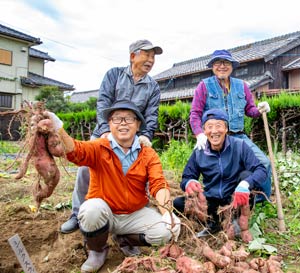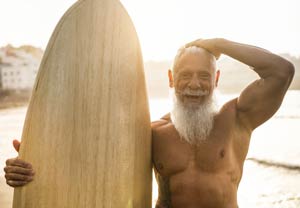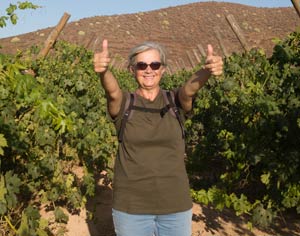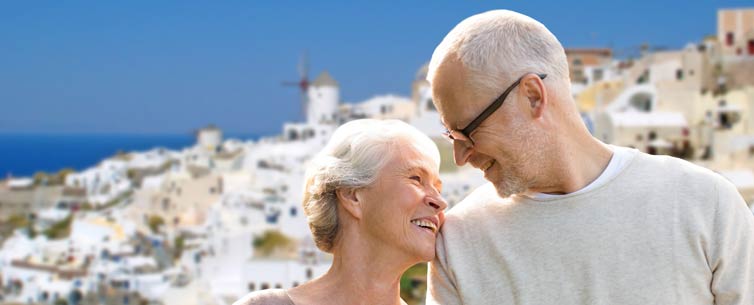Want to live to 100? There’s a lot we can learn from people who have lived long and healthy lives. In fact, research from “Blue Zones” (regions where people live measurably longer) reveals a lot about those who are still very active — even chopping wood — at age 106! The bottom line is that longevity isn't tied to diet fads or extreme exercise; it’s all about adopting simple, sustainable lifestyle choices.
 “It’s a common misconception that living to 100 is all about good genes, but science tells a different story,” says Hayley Flott, PDRMA Wellness Consultant. “While genetics do play a role, research suggests they only account for between 20-to-30 percent of how long we live. The other 70-to-80 percent? That’s shaped by our daily choices — what we eat, how we move, the company we keep and how we manage stress.” That’s why Blue Zones’ research followed the lifestyles of elder populations in Okinawa, Japan; Sardinia, Italy; Ikaria, Greece; Nicoya, Costa Rica; and Loma Linda, California. What researchers learned is there are nine healthy habits most centenarians (those living at least 100 years) in those regions share.
“It’s a common misconception that living to 100 is all about good genes, but science tells a different story,” says Hayley Flott, PDRMA Wellness Consultant. “While genetics do play a role, research suggests they only account for between 20-to-30 percent of how long we live. The other 70-to-80 percent? That’s shaped by our daily choices — what we eat, how we move, the company we keep and how we manage stress.” That’s why Blue Zones’ research followed the lifestyles of elder populations in Okinawa, Japan; Sardinia, Italy; Ikaria, Greece; Nicoya, Costa Rica; and Loma Linda, California. What researchers learned is there are nine healthy habits most centenarians (those living at least 100 years) in those regions share.
Nine Healthy Habits from the Blue Zones
Researchers point out that the habits found in Blue Zones are a natural part of daily life and are not seen as a daily chore to do to stay healthy. The nine principles are:
 Move Naturally: The world's longest-lived people don't go to the gym. Instead, their environment nudges them to be active throughout the day by gardening, walking or doing household chores.
Move Naturally: The world's longest-lived people don't go to the gym. Instead, their environment nudges them to be active throughout the day by gardening, walking or doing household chores.- Purpose: Knowing your "why" for waking up in the morning can add years to your life. Okinawans call it “Ikigai;” Nicoyans call it “plan de vida.”
- Downshift: Even centenarians have stress. The difference is they have daily routines to shed it such as taking a nap, praying or having a social happy hour.
- 80% Rule: People in Blue Zones practice Hara Hachi Bu. This Okinawan phrase reminds them to stop eating when they feel 80% full, preventing overeating.
- Plant Slant: Their diets are primarily plant-based, with beans as a cornerstone. On average, they eat meat just five times per month.
- Wine at 5: In four of the five zones, people enjoy 1-2 glasses of wine daily with friends and food. This habit is about both destressing and social connection.
- Belong: Many people living in Blue Zones belong to a faith-based community. Attending services four times a month can add years to your life.
- Loved Ones First: Centenarians keep their families close, investing time and love in their relationships with spouses, parents and children.
- Right Tribe: Blue Zone social circles support healthy behaviors. These people choose — or are born into — a "tribe" that encourages a healthy lifestyle.
Create Your Own Blue Zone
 You don’t need to move to Costa Rica to start making healthy habits a part of your normal routine. Start by making small changes. “First, pick one or two of the nine principles to try — like making Wednesdays your day for plant-based meals or setting up a regular lunch walk with a coworker. The key is to find what works for you,” advises Flott.
You don’t need to move to Costa Rica to start making healthy habits a part of your normal routine. Start by making small changes. “First, pick one or two of the nine principles to try — like making Wednesdays your day for plant-based meals or setting up a regular lunch walk with a coworker. The key is to find what works for you,” advises Flott.
Here are some easy ways to get started:
- Take a five-minute stretch break during the day.
- Write down one thing you’re grateful for each morning.
- Remember to pause and breathe when you feel stressed.
- Enjoy a screen-free meal with someone you care about.
- Invite someone in your household to join you in making a meal.
- Spend a few minutes outside in nature each day.
“Having others by your side can make healthy habits feel easier and more enjoyable.”
“Small steps like these can make a big difference — you don’t have to do everything at once,” she adds. “Think about what gives your life meaning and how that ties to your daily health habits. Don’t forget to ask friends and family to join you. You’ll create a tribe that supports your positive choices and makes it even more fun to stick to them. Having others by your side can make healthy habits feel easier and more enjoyable.”
Sustainable Approach to Well-being
Think about healthy habits you want to keep for the rest of your life, not just tomorrow or next month. Quick fixes might help for a little while, but real change comes from choices you can stick with every day. When you build these habits into your routine, they become part of who you are — and that’s what keeps you feeling your best, year after year!
PATH Activities
PATH offers many great ways to learn more about Blue Zones and try some healthy habits from the world’s longest living populations.







 “It’s a common misconception that living to 100 is all about good genes, but science tells a different story,” says Hayley Flott, PDRMA Wellness Consultant. “While genetics do play a role, research suggests they only account for between 20-to-30 percent of how long we live. The other 70-to-80 percent? That’s shaped by our daily choices — what we eat, how we move, the company we keep and how we manage stress.” That’s why Blue Zones’ research followed the lifestyles of elder populations in Okinawa, Japan; Sardinia, Italy; Ikaria, Greece; Nicoya, Costa Rica; and Loma Linda, California. What researchers learned is there are nine healthy habits most centenarians (those living at least 100 years) in those regions share.
“It’s a common misconception that living to 100 is all about good genes, but science tells a different story,” says Hayley Flott, PDRMA Wellness Consultant. “While genetics do play a role, research suggests they only account for between 20-to-30 percent of how long we live. The other 70-to-80 percent? That’s shaped by our daily choices — what we eat, how we move, the company we keep and how we manage stress.” That’s why Blue Zones’ research followed the lifestyles of elder populations in Okinawa, Japan; Sardinia, Italy; Ikaria, Greece; Nicoya, Costa Rica; and Loma Linda, California. What researchers learned is there are nine healthy habits most centenarians (those living at least 100 years) in those regions share. Move Naturally: The world's longest-lived people don't go to the gym. Instead, their environment nudges them to be active throughout the day by gardening, walking or doing household chores.
Move Naturally: The world's longest-lived people don't go to the gym. Instead, their environment nudges them to be active throughout the day by gardening, walking or doing household chores. You don’t need to move to Costa Rica to start making healthy habits a part of your normal routine. Start by making small changes. “First, pick one or two of the nine principles to try — like making Wednesdays your day for plant-based meals or setting up a regular lunch walk with a coworker. The key is to find what works for you,” advises Flott.
You don’t need to move to Costa Rica to start making healthy habits a part of your normal routine. Start by making small changes. “First, pick one or two of the nine principles to try — like making Wednesdays your day for plant-based meals or setting up a regular lunch walk with a coworker. The key is to find what works for you,” advises Flott.